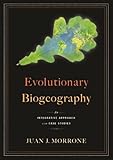Evolutionary biogeography an integrative approach with case studies Juan J. Morrone
Tipo de material: Libro
impreso(a)
Idioma: Inglés Detalles de publicación: New York Columbia University Press c2009Descripción: xvi, 301 páginas ilustraciones, mapas 26 centímetrosISBN:
Libro
impreso(a)
Idioma: Inglés Detalles de publicación: New York Columbia University Press c2009Descripción: xvi, 301 páginas ilustraciones, mapas 26 centímetrosISBN: - 0231143788
- 9780231512831
- 574.9 M67
Bibliografía: páginas 235-286
Glosario: páginas 227-234
Preface.. Chapter 1. INTRODUCING EVOLUTIONARY BIOGEOGRAPHY.. What is evolutionary biogeography?.. Step 1: Identification of biotic components.. Step 2: Testing relationships among biotic components.. Step 3: Regionalization.. Step 4: Identification of cenocrons.. Step 5: Construction of a geobiotic scenario.. How to read this book.. Chapter 2. BASIC CONCEPTS.. Biogeography.. Ecological and historical biogeography.. Hierarchies and scales in biogeography.. Biogeographic patterns.. Biogeographic processes.. Biotic components and cenocrons.. Prediction and retrodiction.. Biogeographic approaches and methods.. Evolutionary biogeography.. For Further reading.. For Discussion.. Chapter 3. A BRIEF HISTORY OF EVOLUTIONARY BIOGEOGRAPHY.. The beginnings of biogeography.. Classical biogeography.. Darwinian biogeography.. Extensionists and other unorthodox biogeographers.. The New York school of zoogeography.. Centers of origin.. Phylogenetic biogeography.. Panbiogeography.. Refuge theory.. Cladistic biogeography.. Panbiogeographers versus cladistic biogeographers.. Cenogenesis, cenocrons and horofaunas.. Taxon pulses.. Phylogeography.. Conclusions.. For Further Reading.. For Discussion.. Chapter 4. IDENTIFICATION OF BIOTIC COMPONENTS.. Biotic components.. Panbiogeography.. Individual tracks.. Generalized tracks.. Nodes.. Areas of endemism.. Methods.. Minimum-spanning tree method.. Case study 4.1: Biogeography and evolution of North American cave Collembola.. Case study 4.2: Distributional patterns of Mexican marine mammals.. Track compatibility.. Case study 4.3: Biogeography of the Subantarctic islands.. Case study 4.4: Biogeography of the Sierra de Chiribiquete (Colombia.. Parsimony analysis of endemicity.. Case study 4.5: Biogeography of the Mexican cloud forests.. Case study 4.6: Distribution of butterflies in the Western Palearctic.. Endemicity analysis
Case study 4.7: Areas of endemism in southern South America.. Evaluation of the methods.. For Further Reading.. Problems.. For Discussion.. Chapter 5. TESTING RELATIONSHIPS AMONG BIOTIC COMPONENTS.. Cladistic biogeography.. Taxon-area cladograms.. Resolved area cladograms.. General area cladograms.. Methods.. Component analysis.. Case study 5.1: Cladistic biogeography of Central Chile.. Brooks parsimony analysis (BPA.. Case study 5.2: Cladistic biogeography of afromontane spiders.. Case study 5.3: Biogeographic history of the North American warm desert biota.. Three area statement analysis.. Case study 5.4: Cladistic biogeography of the "blue ash" eucalypts.. Tree reconciliation analysis.. Case study 5.5: Biogeography of South American assassin bugs (Hemiptera.. Case study 5.6: Biogeography of plant and animal taxa in the Southern Hemisphere.. Paralogy-free subtree analysis.. Case study 5.7: Biogeography of the Northern Andes.. Case study 5.8: Biogeography of Rhododendron section Vireya in the Malesian Archipelago.. Dispersal-vicariance analysis.. Case study 5.9: Historical biogeography of the Subantarctic subregion.. Area cladistics.. Case study 5.10: Cladistic biogeography of the Hawaiian islands.. Phylogenetic analysis for comparing trees.. Case study 5.11: Dispersal of hominines in the Old World.. Evaluation and classification of the methods.. For Further Reading.. Problems.. For Discussion.. Chapter 6. REGIONALIZATION.. Biogeographical classification.. Realms, regions and transition zones.. Regionalization of the world.. Case study 6.1: Regionalization of Latin America.. For Further Reading.. Problems.. For Discussion
Chapter 7. IDENTIFICATION OF CENOCRONS.. Time-slicing.. Methods Temporally partitioned component analysis.. Case study 7.1: Dinosaurian biogeography.. Intraspecific phylogeography.. Case study 7.2: Phylogeography of red deers in Eurasia.. Case study 7.3: Phylogeographic predictions of a weevil species of the Canary Islands.. Molecular clocks.. Case study 7.4: The Mediterranean Lago Mare theory and the speciation of European freshwater fishes.. Case study 7.5: The arrival of caviomorph rodents and platyrrhine primates in South America.. For Further Reading.. Problems.. For Discussion.. Chapter 8. CONSTRUCTION OF A GEOBIOTIC SCENARIO.. Geographic features.. Plate tectonics.. For Further Reading.. For Discussion.. Chapter 9. TOWARD AN INTEGRATIVE BIOGEOGRAPHY.. For Further Reading.. For Discussion.. Glossary.. References.. Author Index.. Subject Index
Rather than favoring only one approach, Juan J. Morrone proposes a comprehensive treatment of the developments and theories of evolutionary biogeography. Evolutionary biogeography uses distributional, phylogenetic, molecular, and fossil data to assess the historical changes that have produced current biotic patterns. Panbiogeography, parsimony analysis of endemicity, cladistic biogeography, and phylogeography are the four recent and most common approaches. Many conceive of these methods as representing different "schools," but Morrone shows how each addresses different questions in the various steps of an evolutionary biogeographical analysis. Panbiogeography and parsimony analysis of endemicity are useful for identifying biotic components or areas of endemism. Cladistic biogeography uses phylogenetic data to determine the relationships between these biotic components. Further information on fossils, phylogeographic patterns, and molecular clocks can be incorporated to identify different cenocrons. Finally, available geological knowledge can help construct a geobiotic scenario that may explain how analyzed areas were put into contact and how the biotic components and cenocrons inhabiting them evolved. Morrone compares these methods and employs case studies to make it clear which is best for the question at hand. Set problems, discussion sections, and glossaries further enhance classroom use. Inglés


